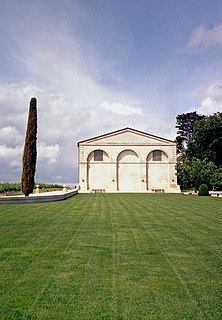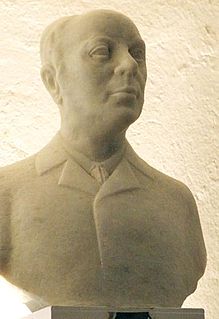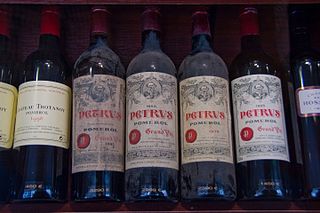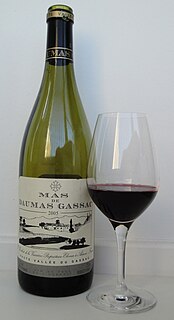
Château Mouton Rothschild is a wine estate located in the village of Pauillac in the Médoc region, 50 km (30 mi) north-west of the city of Bordeaux, France. Originally known as Château Brane-Mouton, its red wine was renamed by Nathaniel de Rothschild in 1853 to Château Mouton Rothschild. In the 1920s it began the practice of bottling the harvest at the estate itself, rather than shipping the wine to merchants for bottling elsewhere.

A varietal wine is a wine made primarily from a single named grape variety, and which typically displays the name of that variety on the wine label. Examples of grape varieties commonly used in varietal wines are Cabernet Sauvignon, Chardonnay and Merlot. Wines that display the name of two or more varieties on their label, such as a Chardonnay-Viognier, are blends and not varietal wines. The term is frequently misused in place of vine variety; the term variety refers to the vine or grape, while varietal refers to the wine produced by a variety.

Philippe, Baron de Rothschild was a member of the Rothschild banking dynasty who became a Grand Prix motor racing driver, a screenwriter and playwright, a theatrical producer, a film producer, a poet, and one of the most successful wine growers in the world.
Penfolds Grange is an Australian wine, made predominantly from the Shiraz (Syrah) grape and usually a small percentage of Cabernet Sauvignon. It is widely considered one of Australia's "first growth" and its most collectable wine. The term "Hermitage", the name of a French wine appellation, was commonly used in Australia as another synonym for Shiraz or Syrah. Penfolds is owned by Treasury Wine Estates.

Wine labels are important sources of information for consumers since they tell the type and origin of the wine. The label is often the only resource a buyer has for evaluating the wine before purchasing it. Certain information is ordinarily included in the wine label, such as the country of origin, quality, type of wine, alcoholic degree, producer, bottler, or importer. In addition to these national labeling requirements producers may include their web site address and a QR Code with vintage specific information.

Bordeaux wine is produced in the Bordeaux region of southwest France, around the city of Bordeaux, on the Garonne River. To the north of the city the Dordogne River joins the Garonne forming the broad estuary called the Gironde; the Gironde department, with a total vineyard area of over 120,000 hectares, is the largest wine growing area in France.

French wine is produced all throughout France, in quantities between 50 and 60 million hectolitres per year, or 7–8 billion bottles. France is one of the largest wine producers in the world, along with Italian, Spanish, and American wine-producing regions. French wine traces its history to the 6th century BC, with many of France's regions dating their wine-making history to Roman times. The wines produced range from expensive wines sold internationally to modest wines usually only seen within France such as the Margnat wines were during the post war period.

Wine fraud relates to the commercial aspects of wine. The most prevalent type of fraud is one where wines are adulterated, usually with the addition of cheaper products and sometimes with harmful chemicals and sweeteners.
Château Brane-Cantenac is a winery in the Margaux appellation of the Bordeaux wine region of France. The wine produced here was classified as one of fifteen Deuxièmes Crus in the original Bordeaux Wine Official Classification of 1855.

Sauternes is a French sweet wine from the region of the same name in the Graves section in Bordeaux. Sauternes wine is made from Sémillon, sauvignon blanc, and muscadelle grapes that have been affected by Botrytis cinerea, also known as noble rot. This causes the grapes to become partially raisined, resulting in concentrated and distinctively flavored wines. Due to its climate, Sauternes is one of the few wine regions where infection with noble rot is a frequent occurrence. Even so, production is a hit-or-miss proposition, with widely varying harvests from vintage to vintage. Wines from Sauternes, especially the Premier Cru Supérieur estate Château d'Yquem, can be very expensive, largely due to the very high cost of production. Barsac lies within Sauternes and is entitled to use either name. Somewhat similar but less expensive and typically less-distinguished wines are produced in the neighboring regions of Monbazillac, Cérons, Loupiac and Cadillac. In the United States, there is a semi-generic label for sweet white dessert wines known as sauterne without the "s" at the end and uncapitalized.

Opus One Winery is a winery in Oakville, California, United States. The wine was called napamedoc until 1982 when it was named Opus One. The winery was founded as a joint venture between Baron Philippe de Rothschild of Château Mouton Rothschild and Robert Mondavi to create a single Bordeaux style blend based upon Napa Valley Cabernet Sauvignon. It is located across State Route 29 from the Robert Mondavi Winery. The creation of this winery venture in 1980 was big news in the wine industry; de Rothschild's involvement added an air of respectability to the burgeoning Napa wine region. The first vintage, 1979 was released in 1984 at the same time as the 1980 vintage. For a while it was the most expensive Californian wine, and to date still ranks among the most expensive red wines produced in the Napa Valley, with the 2014 vintage retailing for $325 per bottle. In 1989 a new winery was built just down the road, the first vintage from the new winery was from 1991 and was released in 1994.
Château d'Armailhac, previously named Château Mouton-d'Armailhacq, Château Mouton-Baron Philippe, Mouton Baronne and Château Mouton-Baronne-Philippe (1979–1988), is a winery in the Pauillac appellation of the Bordeaux region of France. The wine produced here was classified as one of eighteen Cinquièmes Crus in the Bordeaux Wine Official Classification of 1855. In 1989, Baroness Philippine decided to restore its original identity to Mouton d’Armailhacq, giving it the name Château d’Armailhac.
The classification of wine is based on various criteria including place of origin or appellation, vinification method and style, sweetness and vintage, and the grape variety or varieties used. Practices vary in different countries and regions of origin, and many practices have varied over time. Some classifications enjoy official protection by being part of the wine law in their country of origin, while others have been created by, for example, growers' organizations without such protection.

The wine regions of Bordeaux are a large number of wine growing areas, differing widely in size and sometimes overlapping, which lie within the overarching wine region of Bordeaux, centred on the city of Bordeaux and covering the whole area of the Gironde department of Aquitaine.

Château la Mission Haut-Brion is a Bordeaux wine from the Pessac-Léognan appellation, classed among the Crus Classés in the Graves classification of 1953. The winery, located in close vicinity of the city of Bordeaux, belongs to the wine region Graves, in the commune of Talence with additional property in Pessac.

Second wine or second label is a term commonly associated with Bordeaux wine to refer to a second label wine made from cuvee not selected for use in the Grand vin or first label. In some cases a third wine or even fourth wine is also produced. Depending on the house winemaking style, individual plots of a vineyard may be selected, often those of the youngest vines, and fermented separately, with the best performing barrels being chosen for the house's top wine and the other barrels being bottled under a separate label and sold for a lower price than the Grand vin.
Château Rieussec is a sweet white wine ranked as Premier Cru Classé in the original Bordeaux Wine Official Classification of 1855. Belonging to the Sauternes appellation in Gironde, in the region of Graves, the winery is located in the commune of Fargues.
Château Valandraud, or Château de Valandraud, is Bordeaux wine producer situated in the Saint-Émilion appellation, promoted to Premier Grand Cru Classé in the 2012 Classification of Saint-Emilion wine. The winery is located on the Right Bank of France’s Bordeaux wine region in the commune of Saint-Émilion.

Mas de Daumas Gassac is a French wine producer from the wine region Languedoc, classified as Vin de Pays de l'Hérault due to its use of grape varieties outside specifications of its AOC. The winery, producing both white and red wine, is located in the south of France, in the commune of Aniane. Despite its modest designation and location, the vineyard has received widespread acknowledgement, described by The Times to taste like a "Latour" and by the French gastronomic guide GaultMillau as the "Lafite Rothschild of the Languedoc-Roussillon", it is frequently referred to as the Grand cru of the Languedoc.
Henri Enjalbert was a French professor of geography at the University of Bordeaux. He was considered an eminent specialist in wine geology, whose expert opinion frequently overlapped into the fields of oenology, and wine and terroir history, within the Bordeaux region and beyond. Among other credits, he has been called "Bordeaux's most diligent geologist" and "the discoverer of Mas de Daumas Gassac. Among his contentions are that Albania, the Ionian Islands of Greece, and southern Dalmatia in present-day Bosnia and Herzegovina may have been the last European refuge of the grape vine after the Ice Age.












